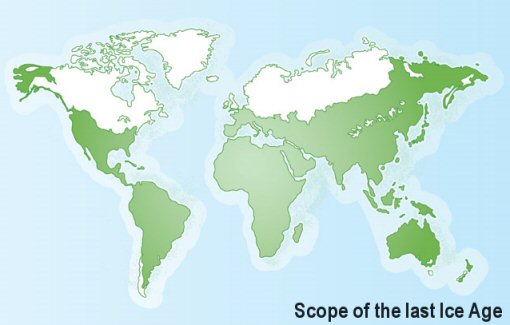
© unknown
Those who ignore the geologic perspective do so at great risk. In fall of 1985, geologists warned that a Columbian volcano, Nevado del Ruiz, was getting ready to erupt. But the volcano had been dormant for 150 years. So government officials and inhabitants of nearby towns did not take the warnings seriously. On the evening of November 13, Nevado del Ruiz erupted, triggering catastrophic mudslides. In the town of Armero, 23,000 people were buried alive in a matter of seconds.
For ninety percent of the last million years, the normal state of the Earth's climate has been an ice age. Ice ages last about 100,000 years, and are punctuated by short periods of warm climate, or interglacials. The last ice age started about 114,000 years ago. It began instantaneously. For a hundred-thousand years, temperatures fell and sheets of ice a mile thick grew to envelop much of North America, Europe and Asia. The ice age ended nearly as abruptly as it began. Between about 12,000 and 10,000 years ago, the temperature in Greenland rose more than 50 °F.
We don't know what causes ice ages to begin or end. In 1875, a janitor turned geologist, James Croll, proposed that small variations in Earth's orbit around the Sun were responsible for climate change. This idea enjoyed its greatest heyday during the 1970s, when ocean sediment cores appeared to confirm the theory. But in 1992, Ike Winograd and his colleagues at the US Geological Survey falsified the theory by demonstrating that its predictions were inconsistent with new, high-quality data.
The climate of the ice ages is documented in the ice layers of Greenland and Antarctica. We have cored these layers, extracted them, and studied them in the laboratory. Not only were ice ages colder than today, but the climates were considerably more variable. Compared to the norm of the last million years, our climate is remarkably warm, stable and benign. During the last ice age in Greenland abrupt climatic swings of 30 °F were common. Since the ice age ended, variations of 3 °F are uncommon.
For thousands of years, people have learned from experience that cold temperatures are detrimental for human welfare and warm temperatures are beneficial. From about 1300 to 1800 AD, the climate cooled slightly during a period known as the Little Ice Age. In Greenland, the temperature fell by about 4 °F. Although trivial, compared to an ice age cooling of 50 °F, this was nevertheless sufficient to wipe out the Viking colony there.
In northern Europe, the Little Ice Age kicked off with the Great Famine of 1315. Crops failed due to cold temperatures and incessant rain. Desperate and starving, parents ate their children, and people dug up corpses from graves for food. In jails, inmates instantly set upon new prisoners and ate them alive.
The Great Famine was followed by the Black Death, the greatest disaster ever to hit the human race. One-third of the human race died; terror and anarchy prevailed. Human civilization as we know it is only possible in a warm interglacial climate. Short of a catastrophic asteroid impact, the greatest threat to the human race is the onset of another ice age.
The oscillation between ice ages and interglacial periods is the dominant feature of Earth's climate for the last million years. But the computer models that predict significant global warming from carbon dioxide cannot reproduce these temperature changes. This failure to reproduce the most significant aspect of terrestrial climate reveals an incomplete understanding of the climate system, if not a nearly complete ignorance.
Global warming predictions by meteorologists are based on speculative, untested, and poorly constrained computer models. But our knowledge of ice ages is based on a wide variety of reliable data, including cores from the Greenland and Antarctic ice sheets. In this case, it would be perspicacious to listen to the geologists, not the meteorologists. By reducing our production of carbon dioxide, we risk hastening the advent of the next ice age. Even more foolhardy and dangerous is the Obama administration's announcement that they may try to cool the planet through geoengineering. Such a move in the middle of a cooling trend could provoke the irreversible onset of an ice age. It is not hyperbole to state that such a climatic change would mean the end of human civilization as we know it.
Earth's climate is controlled by the Sun. In comparison, every other factor is trivial. The coldest part of the Little Ice Age during the latter half of the seventeenth century was marked by the nearly complete absence of sunspots. And the Sun now appears to be entering a new period of quiescence. August of 2008 was the first month since the year 1913 that no sunspots were observed. As I write, the sun remains quiet. We are in a cooling trend. The areal extent of global sea ice is above the twenty-year mean.
We have heard much of the dangers of global warming due to carbon dioxide. But the potential danger of any potential anthropogenic warming is trivial compared to the risk of entering a new ice age. Public policy decisions should be based on a realistic appraisal that takes both climate scenarios into consideration.
Reader Comments
to our Newsletter